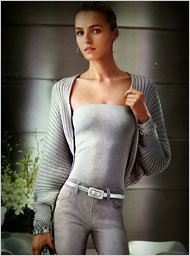By RANDY COHEN
The Issue

photoshopdisasters.blogspot.com
A Ralph Lauren window display in Sydney, Australia, shows a digitally altered image of a model.
A Ralph Lauren ad, featuring a model with hips narrower than her head — so cartoonish, so grotesque, so right for Halloween — has become the latest focus of the already ongoing criticism of digitally altered fashion spreads, even though it ran only in Japan. Foes see such images as harming women by promoting a standard of beauty so false that it can be achieved solely by manipulating a photograph of an already slender model. This image is an extreme example of what happens to many ads, a practice that has become so dubious that some governments are taking action. Should ads using electronically altered images be banned?
The Argument
Yes, say Britain’s Liberal Democrats. At their party conference in September, they called for the prohibition of faked photos that present “overly perfected and unrealistic images” of women in ads aimed at children and warning labels on similar ads aimed at adults. Jo Swinson, a member of Parliament, noted the damage done to women by an unceasing flow of such images, citing rising rates of cosmetic surgery and eating disorders and the anxiety of women constantly judged on their appearance.
She has a point. It is commonplace that women are pressured to meet an artificial standard of beauty. These ads affect men too, giving them false expectations of how women look. Now technology makes that standard unobtainable even by professional beauties, as is evident in paired photographs, pre- and post-Photoshop, of Jessica Alba, Keira Knightley and even, anomalously, Andy Roddick.
French parliamentarians have called not for a ban but for warning labels on manipulated images. The representative Valérie Boyer, a leading proponent of such a law, sees it as an ordinary matter of truth in advertising. “Rules on food-labeling let consumers know the origins of the contents and the presence of things like additives and preservatives,” she said. What’s wrong with “informing them when photographs have also been modified from their original form?”
For us Americans, a ban on such ads might clash with our ideas about free expression, even when what’s expressed is that a particular mascara will lengthen your eyelashes, perhaps by as much as six inches, like twin fans glued to your eyelids, if I catch the implied promise. But we already accept labels that list a product’s ingredients or assess its nutritional value or warn of dangers in its use. Similar transparency should apply to phony-baloney advertising photographs.
There is the counterargument that fashion ads are inherently false: preternaturally beautiful models are worked over by makeup artists and hair stylists, illuminated by lighting designers and shot by sophisticated photographers. In such a context, where can we draw the line on deceit? Here’s where: with the electronic manipulation of a photograph. It may be an arbitrary limit, but we set arbitrary limits all the time. The 55-mile-an-hour speed limit draws on the knowledge of traffic engineers, but it is not a manifestation of some immutable law of nature.
It could also be argued that a labeling law, equitably applied, would require warnings on nearly all ads, including those that alter reality in other ways. For example, few roads are as serenely traffic-free as those in car commercials (and indeed some automobile ads on TV already note that they were photographed on a closed course). But here’s the distinction: Although that open road deliberately conveys a bogus
sense of driving delight, the road itself is not the product. The car is the product. In fashion ads, however, whether for clothes or makeup or shampoo, the model’s beauty is the product, or at least the direct result the product is meant to achieve. Because that beauty cannot be obtained via the proffered merchandise but only through a tricked-out photo, this is a case of false advertising.
Even if the sort of labeling law proposed in France and the U.K. proved to be the camel’s nose in the tent and proliferated to govern all sorts of ads, in all sorts of ways, that’s fine. There is an ethical case for pasting a label on, for instance, overly optimistic beer ads: “Use of this product will not win you the love of magnificent women, unless they drink the beer. And plenty of it.”
It’s easy to imagine even broader warnings that would flag beauty achieved not only electronically but also medically, denoting the particular bits on a model that have been surgically enlarged, reduced or smoothed out. Eventually lingerie ads might require a page of boilerplate, like the ads for prescription drugs, but without restrictions on wearing any particular underwear while operating heavy machinery. Big pharma survived such requirements; big bra can do likewise.
A tougher charge to refute is that such warnings are ineffectual. Simply being told that you’re watching an ad, even a deceptive ad, does not inoculate you against its effects. We like to think we’re too savvy to be seduced by, say, a soda commercial, yet at the supermarket, we are strangely drawn to Coke. Or Pepsi. Or whichever cola ad includes adorable polar bear cubs. Apparently they’re quite thirst-quenching.
Full article here.